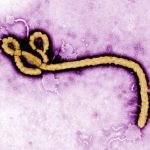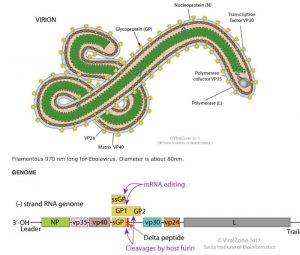Overview
 Since the 1970s, there have been sporadic outbreaks of Ebola in tropical regions of sub-Saharan Africa, however, the 2013-2016 epidemic in West Africa (primarily in the countries of Guinea, Liberia, and Sierra Leone) represents the largest outbreak since the virus was originally identified.
Since the 1970s, there have been sporadic outbreaks of Ebola in tropical regions of sub-Saharan Africa, however, the 2013-2016 epidemic in West Africa (primarily in the countries of Guinea, Liberia, and Sierra Leone) represents the largest outbreak since the virus was originally identified.
The four Ebolaviruses known to cause disease in humans are Bundibugyo virus, Sudan virus, Taï Forest virus, and Ebola virus (formerly Zaire Ebola virus). The fifth, Reston virus, causes Ebola in non-human primates, while the sixth, Bombali virus, is not known to cause disease. Scientists believe that fruit bats or primates, such as apes and monkeys, are the natural reservoir host of Ebola viruses, although this theory is yet to be confirmed. Outbreaks of Ebola occur when a spillover event occurs from a natural reservoir host to a human. This is followed by human-to-human transmission via direct contact with the blood, or other bodily fluids of infected individuals.
The incubation period, from infection to symptom onset, is 2 to 21 days. The early stage of the disease is usually marked by influenza-like symptoms, such as fever, headache, muscle pain, fatigue, and sore throat. These are followed by vomiting, diarrhea, rash, abdominal pain, and in some cases internal and/or external bleeding. Shortness of breath, chest pain, swelling and confusion may also occur. During its onset, it can be difficult to distinguish Ebola from other infectious diseases, such as malaria, typhoid, and meningitis, which increases the risk of transmission. If untreated, the average case fatality rate is ~75%. While no specific treatment options exist for Ebola, supportive care with rehydration and symptomatic treatment has proven to be highly effective decreasing the case fatality rate to 20-25%. A number of experimental treatments are currently being evaluated, and the first Ebola vaccine was approved in 2019, with many more still in development.
Family members and friends caring for loved-ones infected with Ebola virus are at great risk of infections, as are health-care workers treating patients diagnosed with Ebola. The risk increases significantly when appropriate personal protective equipment (PPE) is not available or used properly.
Geographic Distribution
Outbreaks of Ebola have occurred in Democratic Republic of Congo, Gabon, Guinea (with later spread to multiple other countries, including Liberia, Sierra Leone, and Nigeria), South Sudan, and Uganda. Additionally, travelers from affected countries have imported the disease to other countries including Italy, Mali, Nigeria, Senegal, Spain, the United Kingdom, and the United States.
Ebola Diagnostics
Diagnosing Ebola patients has historically been very challenging, due to the extreme biohazard risk, high level of technical expertise required to run laboratory tests, and the lack of necessary resources and infrastructure in areas where outbreaks have occurred. During the 2013-2016 epidemic, however, VHFC investigators developed a new rapid diagnostic tool for diagnosing Ebola patients. Our investigators also developed standard PCR-based tests, that were used to diagnose the first patients in both Sierra Leone and Nigeria by local researchers.
The following methods are currently used to diagnose Ebola:
- reverse transcription polymerase chain reaction (RT-PCR) assay (most common)
- rapid diagnostic test (RDTs)
- antibody-capture enzyme-linked immunosorbent assay (ELISA)
- antigen-capture detection tests
- serum neutralization test
- virus isolation by cell culture
Notably in 2105, a new RDT for the presumptive detection of Ebola virus, developed by VHFC partner institution Corgenix Medical Corporation, received FDA authorization for emergency use. The test was also assessed and listed as eligible for procurement by the WHO. The ReEBOV(TM) Antigen Rapid Test uses a drop of blood from a finger prick to deliver a diagnosis in as little as 15 minutes and is commercially available from Zalgen.
Outlook
Ebola represents a significant public health burden to nations where outbreaks occur, and remains a threat to the global community as a whole. In addition to continuing scientific research to develop effective therapeutics and vaccines, successful control and prevention efforts will require support in disease surveillance, community engagement, health-worker training, case management, contact tracing, good laboratory services, infection control, and safe burial practices.

 Since the 1970s, there have been sporadic outbreaks of Ebola in tropical regions of sub-Saharan Africa, however, the 2013-2016 epidemic in West Africa (primarily in the countries of Guinea, Liberia, and Sierra Leone) represents the largest outbreak since the virus was originally identified.
Since the 1970s, there have been sporadic outbreaks of Ebola in tropical regions of sub-Saharan Africa, however, the 2013-2016 epidemic in West Africa (primarily in the countries of Guinea, Liberia, and Sierra Leone) represents the largest outbreak since the virus was originally identified.